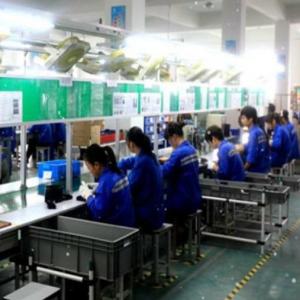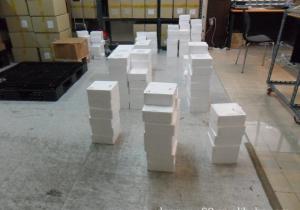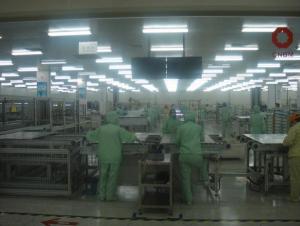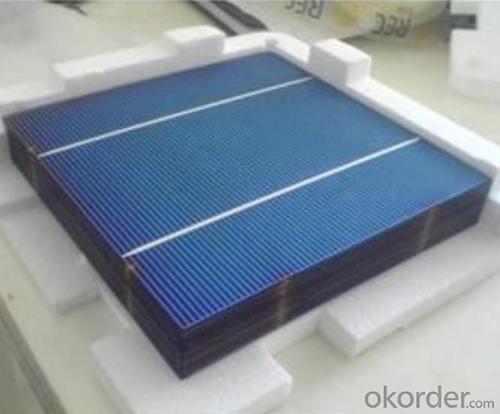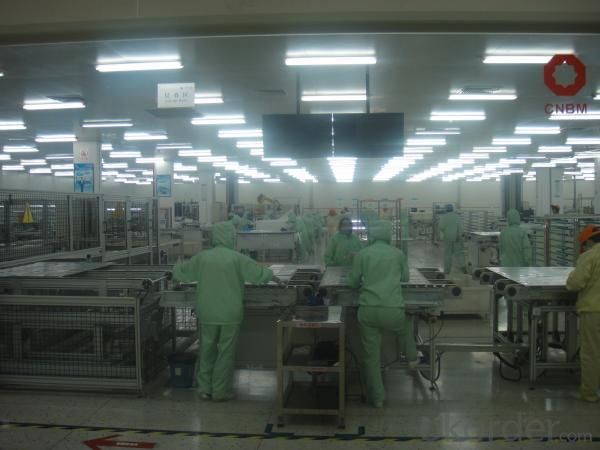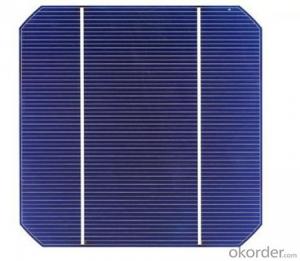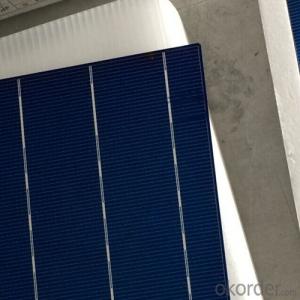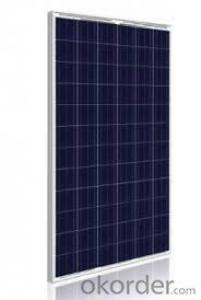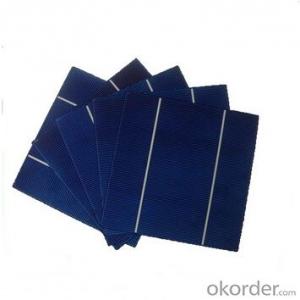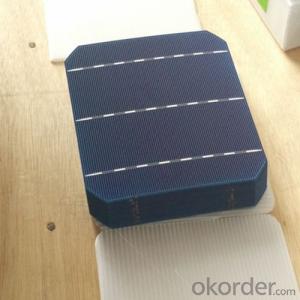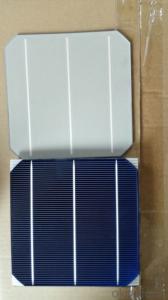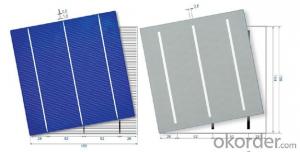Sun Power Solar Cells - High Quality Poly Solar Cell 156mm with TUV, CE Certification
- Loading Port:
- Tianjin
- Payment Terms:
- TT or LC
- Min Order Qty:
- 40000 watt
- Supply Capability:
- 1000 watt/month
OKorder Service Pledge
OKorder Financial Service
You Might Also Like
Details Of Poly Solar Cell 156mm
Specifications Of Poly Solar Cell 156mm
1.Mechanical data and design
Format | 156 mm × 156 mm ± 0.5 mm |
Thickness | 210 μm ± 40 μm |
Front(-) | 1.5mm bus bars (silver),blue anti-reflection coating (silicon nitride) |
Back (+) | 2.5 mm wide soldering pads (silver) back surface field (aluminium) |
2.Temperature Coefficient of Cells
Voc. Temp . coef.%/K | -0.351%/K |
Isc . Temp . coef.%/K | +0.035%/K |
Pm. Temp. coef.%/K | -0.47%/K |
3.Electrical Characteristic
Efficiency (%) | Pmpp (W) | Umpp (V) | Impp (A) | Uoc (V) | Isc (A) | FF (%) |
17.25 | 4.197 | 0.524 | 7.992 | 0.62 | 8.458 | 80.03% |
17 | 4.137 | 0.524 | 7.876 | 0.619 | 8.353 | 80.01% |
16.75 | 4.076 | 0.522 | 7.81 | 0.617 | 8.286 | 79.73% |
16.5 | 4.015 | 0.518 | 7.746 | 0.613 | 8.215 | 79.73 |
16.25 | 3.955 | 0.515 | 7.683 | 0.61 | 8.144 | 79.61% |
16 | 3.894 | 0.512 | 7.613 | 0.608 | 8.075 | 79.31% |
15.75 | 3.833 | 0.51 | 7.534 | 0.605 | 8.058 | 78.62% |
15.5 | 3.772 | 0.508 | 7.453 | 0.604 | 8.02 | 77.87% |
15.25 | 3.771 | 0.505 | 7.35 | 0.604 | 9.997 | 76.83% |
15 | 3.65 | 0.503 | 7.271 | 0.604 | 7.989 | 75.64% |
14.5 | 3.529 | 0.499 | 7.067 | 0.604 | 7.988 | 73.14% |
14 | 3.407 | 0.499 | 6.833 | 0.604 | 7.833 | 72.01% |
4.Intensity Dependence
Intensity [W/m2] | Isc× [mA] | Voc× [mV] |
1000 | 1.00 | 1.000 |
900 | 0.90 | 0.989 |
500 | 0.50 | 0.963 |
300 | 0.30 | 0.939 |
200 | 0.20 | 0.920 |
Advantage Of Poly Solar Cell 156mm
1: High quality cell, Level A cell (14%—17.5%)
2.Dimensione:156*156mm Diagonal:200mm
3: Qualified certification: TUV,CE certification.
4: Warranty: five years for whole unit
Usage/Application Of Poly Solar Cell 156mm
Packaging & Delivery Of Poly Solar Cell 156mm | |
Packaging Detai | Packaging Detail:Export Carton and Pallet or under customer request. |
Delivery Detail:10-20days | |
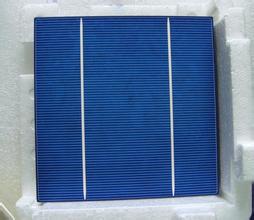
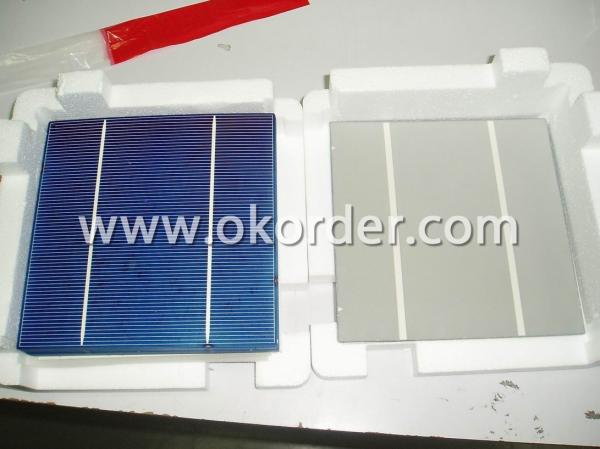
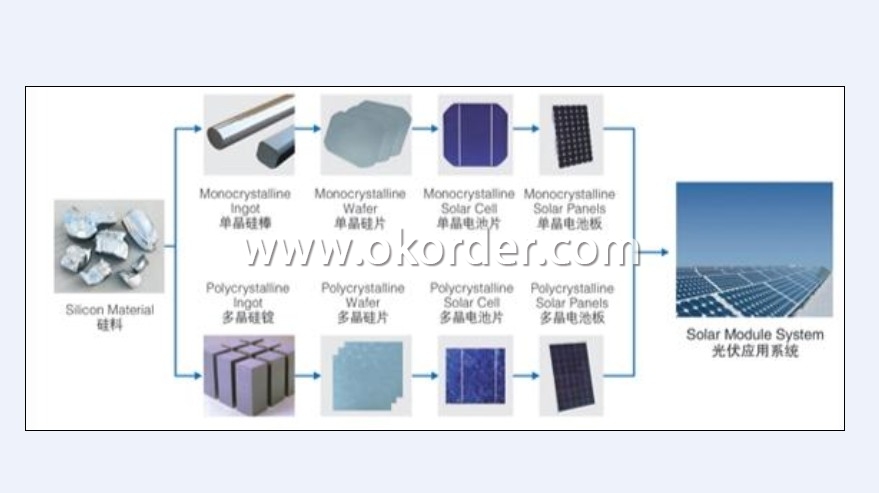
Latest research progress of Polymer Solar Cells
Compared with mature inorganic silicon solar cells from its conversion efficiency and stability, Polymer Solar Cells is still in the development stage. However, due to the advantages of having a light weight, low cost, flexible devices can be made, and a wet film formation (spin coating, ink jet printing and screen printing) technology and other large area, the organic polymer solar cells become one of the hottest areas of research.
Photoelectric conversion efficiency of solar cells is determined by the open-circuit voltage of the battery, short-circuit current, and fill factor, so how to improve the aforementioned three factors, the conversion efficiency of solar cells is a key factor in increasing.
A joint research team from the University of California and the University of Cambridge consisting proposed PIPCP in recent journal Advanced Materials: PC61BM conjugated polymer ─ fullerene heterojunction solar cells latest research body, proposed a lifting battery open circuit voltage the method can significantly improve the photoelectric conversion efficiency of the device.
The paper pointed out that when the organic material absorbed photon excited state is formed, the excited state is seen as the static electricity in a combination of electrons and holes, known as excitons. Since the exciton properties of the organic semiconductor, the driving force of the charge separation in a solar cell is the donor and acceptor materials, the energy difference. Electronic circuit voltage depends on solar photovoltaic bandgap and bandgap is the recipient of the lowest unoccupied molecular orbital (LUMO) and to the body between the highest occupied molecular orbital (HOMO) energy difference.
Receptor lowest unoccupied molecular orbital wave function of the body and to the highest occupied molecular orbital overlap between the interface can create a form, this interface morphology and related electronic open-circuit voltage, called the charge transfer state (CTS). In fixed offsets, energy and electronic charge transfer state open circuit voltage linear relationship, even with the temperature close to the same value obtained when 0K, which shows the energy charge transfer state may limit the open circuit voltage of the electron. By reducing energy loss in the electronic band gap to the open circuit voltage, can effectively enhance the photoelectric conversion efficiency of the organic polymer solar cell.
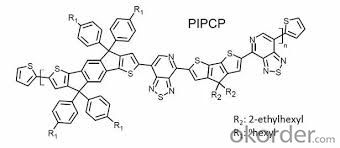
- Q: What are the advantages and disadvantages of solar panels and diodes?
- If it is parallel in the positive and negative, then the protective effect, the diode is connected to the negative power supply, the diode negative connected to the positive power supply.
- Q: Can solar cells be used to power an entire household?
- Yes, solar cells can be used to power an entire household, depending on the size of the solar panel system and the energy needs of the household. A properly designed and adequately sized solar power system can generate enough electricity to meet the daily energy requirements of a household, providing clean and renewable energy.
- Q: Can solar cells be used to power remote weather stations?
- Yes, solar cells can be used to power remote weather stations. Solar cells convert sunlight into electricity, providing a reliable and sustainable power source for remote locations. This eliminates the need for traditional power grid connections and reduces operating costs. Additionally, solar cells can be easily installed and maintained in remote areas, making them an ideal solution for powering weather stations in such locations.
- Q: What is the impact of solar cell installations on job creation?
- Solar cell installations have a significant positive impact on job creation. By promoting the growth of the renewable energy sector, these installations create a wide range of job opportunities across various fields such as manufacturing, installation, maintenance, and research. The demand for skilled workers in solar-related industries has been steadily increasing, leading to job creation and economic growth. Additionally, the solar industry often provides employment opportunities at both the local and national levels, contributing to the overall development of the workforce and the economy.
- Q: Can solar cells be used in vehicles?
- Yes, solar cells can be used in vehicles. They are commonly used in electric vehicles (EVs) to charge the battery and provide power to various systems, increasing their range and efficiency. Solar panels can be installed on the roof or hood of a vehicle to capture sunlight and convert it into electricity, helping to reduce reliance on grid charging and decrease carbon emissions.
- Q: How long do solar cells last?
- Solar cells typically have a lifespan of around 25 to 30 years. However, with proper maintenance and regular cleaning, solar cells can continue to generate electricity for even longer periods.
- Q: What is the solar cell?
- The type of solar cells can be divided according to the materials used: silicon solar cells, solar cells and organic semiconductor system of solar cells.
- Q: How do solar cells impact energy poverty?
- Solar cells have the potential to significantly impact energy poverty by providing clean and sustainable electricity to communities that lack access to reliable energy sources. As solar cells generate electricity from sunlight, they offer an affordable and renewable solution for off-grid areas, reducing dependency on expensive and polluting fossil fuels. By enabling access to electricity, solar cells can improve education, healthcare, and economic opportunities, ultimately helping to alleviate energy poverty.
- Q: Can solar cells be used in public transportation?
- Yes, solar cells can be used in public transportation. Solar panels can be installed on the roofs of buses, trains, and trams to generate electricity from sunlight. This renewable energy can be used to power various systems in public transportation, such as lighting, air conditioning, and even charging onboard devices. Additionally, solar cells can also be used to charge electric vehicles used in public transportation, reducing reliance on fossil fuels and contributing to a more sustainable transportation system.
- Q: Are solar cells affected by shade or partial shading?
- Yes, solar cells are affected by shade or partial shading. When a solar cell is shaded, its performance is significantly reduced as shade blocks the sunlight needed to generate electricity. Even a small amount of shade on a portion of the solar cell can greatly impact its overall efficiency and output. Therefore, it is important to avoid shade or find ways to minimize its impact on solar panels to ensure optimal energy production.
1. Manufacturer Overview
| Location | SanShui City, Guang Dong, China. |
| Year Established | 2009 |
| Annual Output Value | Above 10 billion RMB |
| Main Markets | Mid East;Western Europe;North America;Southeast Asia |
| Company Certifications | TUV ISO9001;SGS |
2. Manufacturer Certificates
| a) Certification Name | |
| Range | |
| Reference | |
| Validity Period |
3. Manufacturer Capability
| a) Trade Capacity | |
| Nearest Port | Zhuhai, Foshan |
| Export Percentage | 0.4 |
| No.of Employees in Trade Department | about 600 |
| Language Spoken: | English;Chinese; |
| b) Factory Information | |
| Factory Size: | 66666.7m2 |
| No. of Production Lines | 12 |
| Contract Manufacturing | OEM Service Offered;Design Service Offered |
| Product Price Range | USD 0.3-0.45/Wp |
Send your message to us
Sun Power Solar Cells - High Quality Poly Solar Cell 156mm with TUV, CE Certification
- Loading Port:
- Tianjin
- Payment Terms:
- TT or LC
- Min Order Qty:
- 40000 watt
- Supply Capability:
- 1000 watt/month
OKorder Service Pledge
OKorder Financial Service
Similar products
Hot products
Hot Searches
Related keywords

